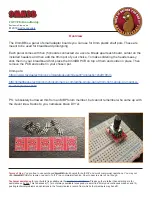
MECHANICAL SPECIFICATIONS
Operating Temperature:
14° to 122°F (-10° to 50°C)
Storage Temperature:
-13° to 176°F (-25° to 80°C)
Influence of Temperature:
<0.1% per 10°K
Jaw Opening:
3.54" (90 mm)
Maximum Conductor Size:
Cable: 2.52" Ø max. (64 mm)
Bus bar: 1.97 x 5.31" (50 x 135 mm)
2.52 x 3.94" (64 x 100 mm)
Envelope Protection:
IP 20 (IEC 529)
Drop Test:
500 mm (IEC 68-2-32)
Mechanical Shock:
100 g (IEC 68-2-27)
Vibration:
10/55/10 Hz, 0.15 mm (IEC 68-2-6)
Polycarbonate Material:
Handles: 10% fiberglass charged
polycarbonate UL 94 V0
Jaws: ABS UL 94 V2
Dimensions:
4.72 x 12.40 x 1.89" (120 x 315 x 48 mm)
Weight:
2.65 lbs (1200 g)
Colors:
Dark gray handles with red jaws
Output:
5 ft (1.5 m) lead with safety 4 mm banana
plug
SAFETY SPECIFICATIONS
Electrical:
Double insulation or reinforced insulation
between primary or secondary and outer
case of handle upon IEC 1010-2-32
Common Mode Voltage:
600 V CAT III, Pollution: 2
ORDERING INFORMATION
Current Probe JM810A
........
Cat. #2110.80
Accessories
Banana plug adapter
(to non-recessed plug)...........
Cat. #1017.45
OPERATION
Please make sure that you have already read and fully understand the WARNING section
on page 1.
Making Measurements with the AC Current Probe Model JM810A
■
Connect the black and red terminals to the Ampere AC range of your DMM or current
measuring instrument. Select the appropriate current range (2 A
ac
). Clamp the probe
around the conductor to be tested. If the reading is less than 200 mA, select the lower
range until you obtain the best resolution. Read the value display on the DMM and
multiply it by the probe ratio (1000/1). (If the reading = 0.592 Aac, the current flowing
through the probe is 0.592 A x 1000 = 592 Aac
).
■
For best accuracy: carefully center the conductor inside the probe jaw, avoid if possible,
the proximity of other conductors which may create noise.
Tips for Making Precise Measurements
■
When using a current probe with a meter, it is important to select the range that provides
the best resolution. Failure to do this may result in measurement errors.
■
Make sure that probe jaw mating surfaces are free of dust and contamination.
Contaminants cause air gaps between the jaws, increasing the phase shift between
primary and secondary. It is very critical for power measurement
.






















